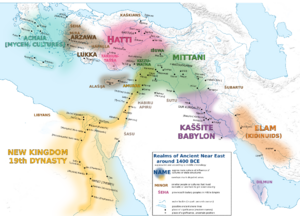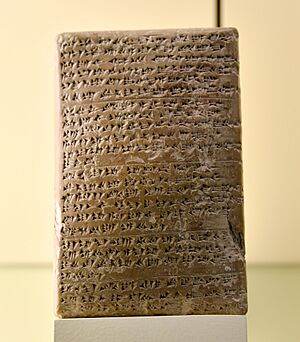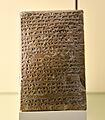Alashiya facts for kids

Alashiya, also spelled Alasiya, was an important ancient kingdom that existed during the Middle and Late Bronze Age. It was located somewhere in the Eastern Mediterranean region. Alashiya was a major supplier of valuable goods, especially copper, to powerful ancient lands like ancient Egypt and other states in the Ancient Near East.
Today, experts believe that Alashiya was the ancient name for the island of Cyprus, or at least a big part of it. This idea was strongly supported by scientific studies of ancient clay tablets. These tablets were sent from Alashiya to other rulers and helped scientists figure out where the clay came from.
Contents
Messages from the Past
The name Alashiya appears in many ancient writings. These include texts written in Egyptian, Hittite, Akkadian, Mycenaean (a very old Greek language), and Ugaritic (another ancient language).
The Amarna Letters
Some of the most interesting clues about Alashiya come from the Amarna letters. These are a collection of clay tablets found in Egypt. They contain messages between the rulers of Egypt and other kingdoms, including Alashiya.
The letters from Alashiya's king or his officials mostly talk about how much copper they sent to Egypt. In return, they often asked for silver or ivory. For example, one letter mentions 500 talents of copper, which is about 12.5 tons! The king of Alashiya even called the Egyptian Pharaoh his "brother." This shows that Alashiya's king saw himself as an equal, probably because his kingdom was so important for trade.
Later, a document called Papyrus Anastasi IV also mentioned copper (and even cows) being sent from Alashiya to Egypt. This shows that the trade continued for a long time.
Other Ancient Writings
Other texts also mention Alashiya. In one letter from the city of Ugarit, the king of Ugarit asked Alashiya for military help. Another document from Ugarit tells us that two princes were sent away to "the land of Alashiya."
One text from Ugarit might even hint at where Alashiya's capital city was. It could mean the city was on a mountain, but it's more often translated as being on the coast. The first known name of a king from Cyprus, Kushmeshusha, appears in letters sent to Ugarit in the 13th century BC.
The Story of Wenamun
An ancient Egyptian story called the Story of Wenamun also mentions Alashiya. In this tale, an Egyptian priest named Wenamun was sailing from Byblos to Egypt when his ship was blown off course. He ended up in Alashiya. Wenamun reported that a large, angry crowd almost killed him, but he was saved by Hatbi, who was the "princess of the town."
Alashiya and the Hittites
Around 1400 BC, the Hittite king Arnuwanda I was upset with his vassal (a ruler under his control) named Madduwatta. Madduwatta had been raiding Alashiya. The Hittite king said that Alashiya was actually Hittite territory. Madduwatta claimed he didn't know this.
Later, around 1200 BC, other Hittite kings, Tudhaliya IV and Suppiluliuma II, fought battles in Alashiya. They forced Alashiya's king to sign a treaty, agreeing to be under Hittite rule.
Where Was Alashiya?
For a long time, historians and archaeologists debated where Alashiya was located. We know it was a major source of copper for other countries in the East Mediterranean. This means it had to be:
- A place with lots of copper production during the Bronze Age.
- Located on the coast, so it could trade by sea.
- In the East Mediterranean region.
Some scholars thought Alashiya might be in Syria or Turkey. However, most experts now agree that Alashiya refers to at least part of the island of Cyprus.
The Clues from Clay
A big breakthrough happened in 2003. Scientists studied the clay used to make the Amarna and Ugaritic letters sent from Alashiya. They looked at the minerals and chemicals in the clay. This analysis showed that the clay did not come from Syria. Instead, it matched clay found on Cyprus very well.
However, the analysis also showed that the clay didn't come from near Enkomi, which many thought was the capital of Alashiya. The clay matched areas near Kalavasos and Alassa on Cyprus. These sites, especially Kalavasos, were also important during the Late Bronze Age and were close to copper mines.
So, it's still not completely clear if the kingdom of Alashiya covered all of Cyprus, with its capital city moving over time (maybe starting at Enkomi). Or perhaps Alashiya was always centered at Kalavasos, or maybe it was just one important region of Cyprus. The mystery continues!
See Also
- Bronze Age Cyprus
- Sea Peoples
- Late Bronze Age collapse
Images for kids






